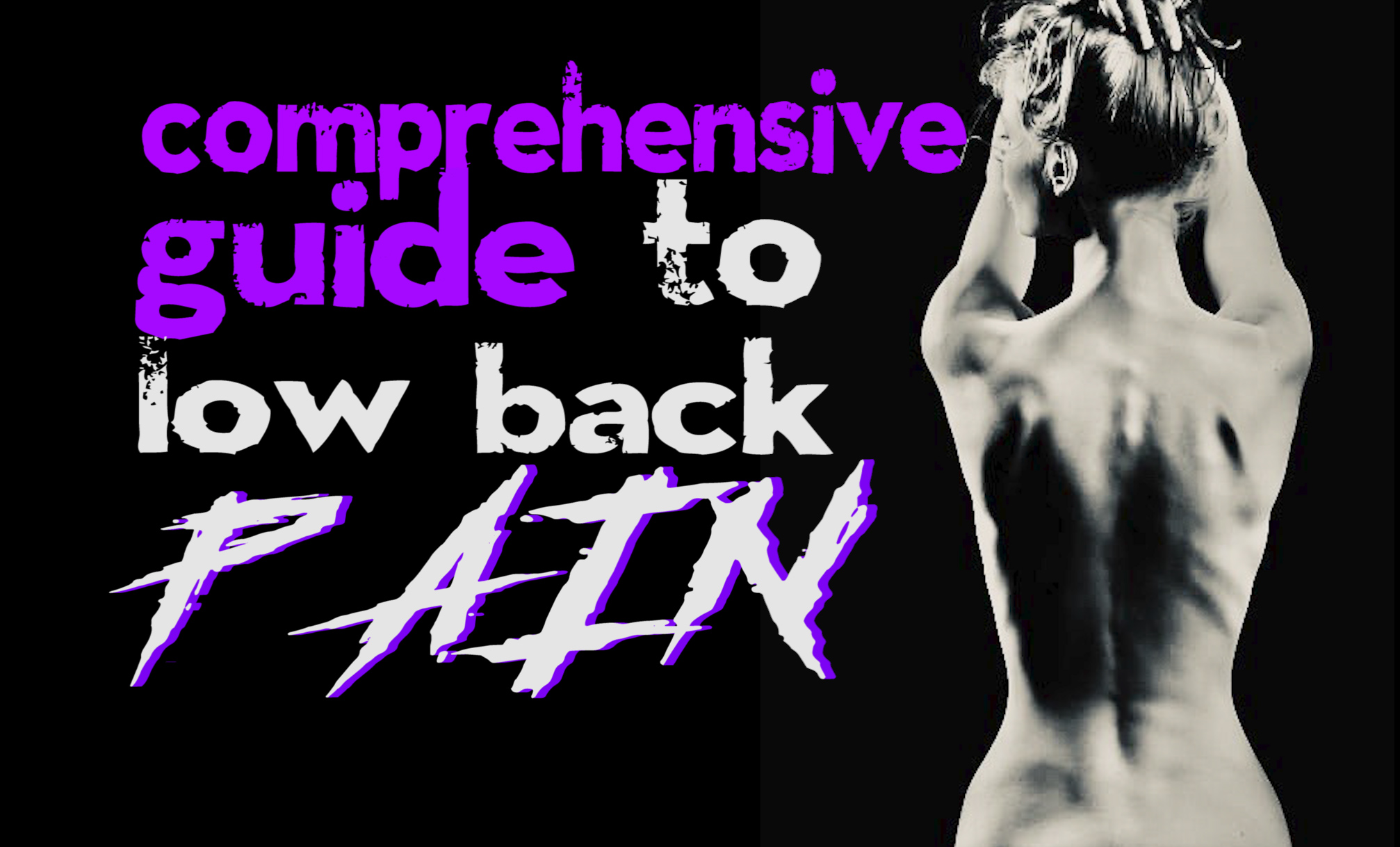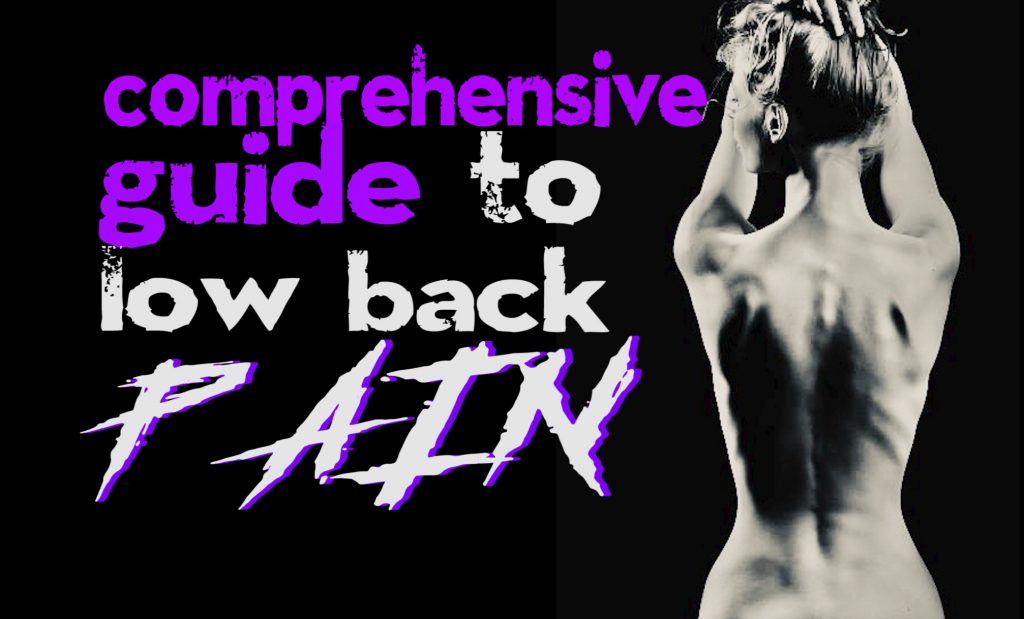A Comprehensive Guide To Low Back Pain: Everything You Need To Know
Overview
Low back pain is one of the most common complaints that drive regular people and athletes to hospitals and private clinics.
According to the National Institute of Neurological Disorders and Stroke (NINDS), around 80% of all people experience low back pain for at least one time in their lives. By far, people between the ages of 30–50 are the most susceptible age group.
Unfortunately, the lower portion of the back has complex anatomy, with various structures, which eventually makes the diagnosis quite difficult.
In medicine, doctors define acute back pain as a sensation of discomfort that lasts between a few days to less than 3 months. Exceed this time frame, and we’ll be dealing with chronic back pain.
In this article, we will cover the causes, diagnosis, and treatment options of low back pain. We will also discuss the impact of strength training on this condition.
The causes of low back pain
Lumbar strain
This is an umbrella term that describes an injury to one of the following structures:
- Tendons
- Ligaments
- Muscles
When the pressure applied to these structures exceeds normal values, microscopic tears occur. These will send signals to the brain, producing a sensation of pain.
According to the latest guidelines, experts don’t recommend staying in bed for a prolonged period of time.
Lumbar radiculopathy
Commonly known as sciatica, lumbar radiculopathy takes place when the disks become weak, which forces the soft portions to herniate.
Patients with lumbar radiculopathy get triaged to opt for medical or surgical treatment (e.g., minimally invasive lumbar spine surgery).
Arthritis
Arthritis describes an active inflammation of the joints (e.g., elbows, wrists, knees). When this condition affects the lower back, we refer to it as spondyloarthropathy.
With time, the vertebrae might fuse together, leading to severe restriction in the range of motion and continuous pain.
The symptoms of low back pain
While most of you are familiar with the classic symptoms that accompany back pain (e.g., stiffness, immobility), this section will focus on the potentially dangerous symptoms that require specialized care as soon as possible.
Fever
When your fever starts simultaneously with back pain, it may be an indication of a spinal infection (e.g., osteomyelitis) that’s eroding the bony structures.
Eventually, this causes osteolysis (i.e., the breakdown of bone). In left untreated, you could develop a more severe condition known as sepsis (i.e., the spread of the infection in the bloodstream).
If you experience high-grade fever with back pain, make sure to contact your primary care physician.
Numbness and weakness
Numbness and weakness of the lower limbs with back pain indicate direct damage to the nerves, which is a surgical emergency that requires immediate attention!
Loss of sphincter control
The loss of sphincter control manifesting as urinary or bowel incontinence may reveal serious nerve damage to the nerves that usually control the muscles around your sphincters.
Fortunately, receiving the proper medical/surgical care in time should alleviate these symptoms. However, patients may need physical therapy in some cases.
Diagnosis of low back pain
The diagnosis of low back pain is straightforward. However, identifying the etiology of the pain is somewhat tricky.
To make the diagnosis, the physician will take into account the information gathered from:
- The history of the patient
- The findings of the physical examination
- The test results (e.g., blood tests, imaging tests)
Based on this data, the origin of the pain will be determined along with the underlying medical condition that’s triggering it.
The treatment of low back pain
Depending on the origin of the pain, there are two major ways to address this condition:
Medical treatment
This involves the prescription of pharmacological drugs, such as acetaminophen and Non-Steroidal Anti-Inflammatory Drugs (NSAIDs).
In some cases, the physician will opt for more potent drugs, including corticosteroids, narcotic painkillers, and muscle relaxants.
Surgical treatment
For the most part, doctors prefer to avoid surgery since it can lead to serious complications. However, surgical therapy might be the only option for a group of patients.
Here are the common procedures performed to fix low back pain:
- A discectomy
- A foraminotomy
- Intradiscal electrothermal therapy (IDET)
- A nucleoplasty
- Radiofrequency lesioning
- Spinal fusion
- A spinal laminectomy
Practice mindfulness
Practicing mindfulness (e.g., yoga, meditation) increases the release of endorphins.
These chemicals have potent analgesic (i.e., pain-relieving) properties on the central nervous system, which reduces pain, stress, and anxiety.
Exercise
As we mentioned above, current guidelines advise against complete immobility after injuring your back.
You see, moving around helps your body heal faster, especially when targeting the right muscle groups.
For instance, the abdominal muscles significantly reduce the pressure applied to your back. Therefore, you should prioritize exercising these to reduce the frequency of low back injuries.
Get better sleep
Healthy sleep improves hormonal balance, restores your energy, and relieves pain. Sleeping sufficient hours will also promote the tissue-repair biochemical cascades, which helps you get back on your feet quickly.
The prevention of low back pain
Here are some practical tips to prevent low back injuries:
Warming up
As you already know, warming up is the most important step in every exercise session. You can start by doing some low-impact exercises, such as jogging, cycling, or simply walking.
This will allow the synovial fluid to move around your joints, especially those under high tension (e.g., hips, knees, elbow).
In the latest guidelines of sports injuries, researchers recommended to follow these movements to reduce the risk of musculoskeletal injures:
- Forward running (1-2 laps)
- Forward run with zig-zag (1-2 laps)
- One leg jump over a line
- Jumps in place
Cooling down
The cooling down phase is as important as warming up.
Your primary goal is to gradually decrease your cardiac output and heart rate, which allows your muscles to recover.
According to guidelines, the optimal cool-down routine consists of 5–10 minutes of light jogging, walking, or knee-to-chest pose.
Interestingly, cooling down properly reduces the risk of delayed onset muscle soreness (DOMS).
Listen to your body
Telling the difference between good and bad pain is a crucial skill that you need to learn.
Some of you might be thinking: “what’s a good pain?”
A good sensation of pain is the discomfort you feel during exercise; it is a sign that your muscles are undergoing so much pressure, which is exactly what you want to feel when working out.
Conversely, sudden pain that’s sharp and intense is a warning sign that something is not working right.
How does strength training improve low back pain?
Most people think that immobilizing their spine after feeling pain is the best approach to heal. However, researchers believe that stretching and exercising after a physical injury to your back might accelerate your recovery.
This is not to say that you should push yourself in the gym when you suddenly feel pain in your lower back. On the contrary, if you experience any unusual feeling of pain in the gym (regardless of its location), you should stop what you’re doing to avoid exacerbating the situation.
Strength training exercise for back pain
To reduce your risk of injury
For most of the week, people often engage in a sedentary lifestyle, which makes them susceptible to numerous diseases (e.g., obesity, diabetes, cardiovascular disease) and musculoskeletal injuries (e.g., knee pain, low-back pain).
While incorporating strength training in your weekly routine might help you break out of this vicious cycle, training too hard puts your back at risk for injury.
Therefore, when you target your back, it will become more resilient to intense workouts, which reduces the risk of injury.
To improve posture
Exercising your back can help you get rid of bad posture by correcting the “hunched form” you get after sitting for long hours on your desk.
By strengthening your back muscles, you’ll be able to maintain the alignment of your spine, which improves your overall posture.
To temper down lower back pain
Back exercises combined with a good stretching routine can significantly reduce your back pain. This is due to the strengthening of the muscle fibers and the higher threshold of tension your back can handle.
Top 5 back workouts with dumbbells
Back exercise for strength
This exercise focuses on building the strength of the back muscles, which means it’s based on loading with progressively heavier loads.
Here’s an example:
Pullup powered dumbbell
As you do your regular pull-up exercise, try to add some weight by attaching a dumbbell to your lower body, using a leash, or just locking it with both of your feet.
The extra weight will make the pullup much more challenging, which puts extra stress on your back muscles, and eventually, builds strength.
Each time you get too comfortable with the current weight, try to increase the load.
Back exercise for power
The two most important elements to increase power are speed and explosivity that you can get from various exercises.
Here’s an example:
Dumbbell dead row
- As the dumbbells sit on the floor, place yourself in a position similar to the deadlift.
- Lift the dumbbells off the floor, using the strength of your legs.
- Once the dumbbells are above your back with the elbows extended, lower the dumbbells back to the floor and repeat.
The best thing about this exercise is that it doesn’t have any momentum to count on, which creates explosivity by using your arms and legs to lift the dumbbells from the floor.
To make this exercise more efficient, try to increase the weight as much as you can handle.
Back exercise for metabolic effect
The focus of metabolic exercises is to create the burning sensation that comes with repeated movements of the dumbbell.
While the bent-over dumbbell row might seem like a good option in this situation, it places too much strain on the lower back, which is why we opted for another variation.
Here’s an example:
Chest supported touch rows
- Place yourself on the incline bench (protects the lower back).
- Put two dumbbells on the floor and grab another two in your hands (4 dumbbells in total).
- As you do the dumbbell row, your goal is to touch the ones you placed on the floor to target the lats.
- Once you’re nearing failure, ditch the dumbbells in your hands and grab the ones on the floor to keep the metabolic effect going.
Back exercise for a total-body workout
Obviously, to do a total-body workout, you need to involve the majority of muscle groups. Consequently, the exercises in this category are complex and include several movements.
Here’s an example:
The Manmaker
This exercise can be divided into three major categories:
The pushup phase
- Place yourself in a pushup position while grabbing the dumbbells.
- Perform one pushup and move on to the next phase.
The renegade row phase
- While keeping your back straight, do a renegade row for both sides of your body.
The jumping phase
- Once you finish the renegade row, bring your feet forward and switch to a standing position.
- Lift the dumbbells above your head, then go back to the pushup position.
Back exercise for hypertrophy
As the name implies, this exercise focuses on increasing muscle volume, which is best performed by targeting specific regions of the back to reduce the interference of other muscle groups.
Here’s an example:
Dumbbell pullover
The dumbbell pullover is one of the best exercises that strengthens your lower back muscles and your lats.
Check out this blog post for a comprehensive guide on the dumbbell pullover.
Other back exercises
Kettlebell swings
Not only will this exercise help you build a strong core, but it will also strengthen your back muscles.
Make sure to perform the swings with your feet slightly widened, knees bent, and kettlebell held with two hands between your feet.
Once you’re in position, lean forward without compromising spinal alignment.
Swing the kettlebell backward until it’s just behind your feet, then swing it again until it reaches the shoulders’ level.
Wide-grip pull-ups
This exercise is a variety of regular pull-ups.
Instead of placing your hands at the shoulders’ level, you should widen your grip.
It is crucial to do this exercise in the right form, as it can lead to muscle strain.
Dumbbell single-arm row
This one is a classic.
It involves working both sides of your back and strengthening the weaker spots. It is important to keep your shoulder in the right position.
Doing this exercise frequently produces excellent results in people who suffer from lower back pain.
Farmers’ walk
Farmers’ walk is a simple exercise that conceals numerous benefits. This exercise strengthens the muscles of your back, shoulder, and forearms.
To perform the farmers’ walk, you need to hold one dumbbell with each hand as you walk for short distances.
Takeaway message
Low back pain is one of the most common injuries in the field of fitness and people with a sedentary lifestyle.
We hope that this article managed to simplify this complex topic into understandable bits. We also hope that you are now more aware of the role of strength training in treating and preventing low back injuries.
If you have any questions, concerns, or just something that you want to add, please don’t hesitate to share your thoughts in the comment section below.
Learn more about strength training exercises by clicking on this link.


